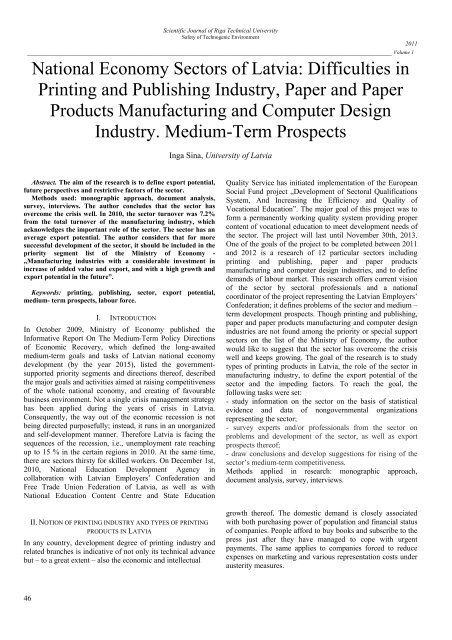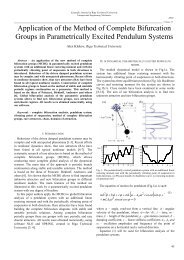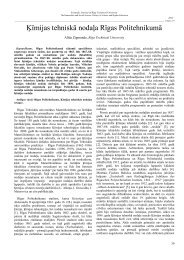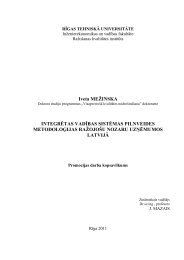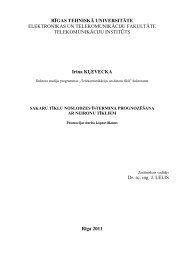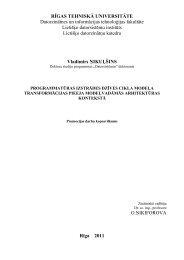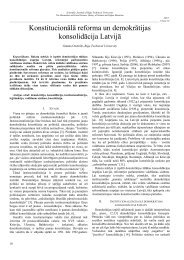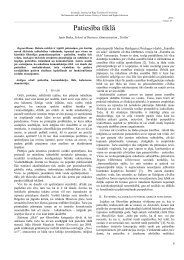Full text - ortus
Full text - ortus
Full text - ortus
You also want an ePaper? Increase the reach of your titles
YUMPU automatically turns print PDFs into web optimized ePapers that Google loves.
Scientific Journal of Riga Technical University<br />
Safety of Technogenic Environment<br />
________________________________________________________________________________________________ Volume 1<br />
46<br />
National Economy Sectors of Latvia: Difficulties in<br />
Printing and Publishing Industry, Paper and Paper<br />
Products Manufacturing and Computer Design<br />
Industry. Medium-Term Prospects<br />
Abstract. The aim of the research is to define export potential,<br />
future perspectives and restrictive factors of the sector.<br />
Methods used: monographic approach, document analysis,<br />
survey, interviews. The author concludes that the sector has<br />
overcome the crisis well. In 2010, the sector turnover was 7.2%<br />
from the total turnover of the manufacturing industry, which<br />
acknowledges the important role of the sector. The sector has an<br />
average export potential. The author considers that for more<br />
successful development of the sector, it should be included in the<br />
priority segment list of the Ministry of Economy -<br />
„Manufacturing industries with a considerable investment in<br />
increase of added value and export, and with a high growth and<br />
export potential in the future”.<br />
Keywords: printing, publishing, sector, export potential,<br />
medium- term prospects, labour force.<br />
I. INTRODUCTION<br />
In October 2009, Ministry of Economy published the<br />
Informative Report On The Medium-Term Policy Directions<br />
of Economic Recovery, which defined the long-awaited<br />
medium-term goals and tasks of Latvian national economy<br />
development (by the year 2015), listed the governmentsupported<br />
priority segments and directions thereof, described<br />
the major goals and activities aimed at raising competitiveness<br />
of the whole national economy, and creating of favourable<br />
business environment. Not a single crisis management strategy<br />
has been applied during the years of crisis in Latvia.<br />
Consequently, the way out of the economic recession is not<br />
being directed purposefully; instead, it runs in an unorganized<br />
and self-development manner. Therefore Latvia is facing the<br />
sequences of the recession, i.e., unemployment rate reaching<br />
up to 15 % in the certain regions in 2010. At the same time,<br />
there are sectors thirsty for skilled workers. On December 1st,<br />
2010, National Education Development Agency in<br />
collaboration with Latvian Employers’ Confederation and<br />
Free Trade Union Federation of Latvia, as well as with<br />
National Education Content Centre and State Education<br />
II. NOTION OF PRINTING INDUSTRY AND TYPES OF PRINTING<br />
PRODUCTS IN LATVIA<br />
In any country, development degree of printing industry and<br />
related branches is indicative of not only its technical advance<br />
but – to a great extent – also the economic and intellectual<br />
Inga Sina, University of Latvia<br />
2011<br />
Quality Service has initiated implementation of the European<br />
Social Fund project „Development of Sectoral Qualifications<br />
System, And Increasing the Efficiency and Quality of<br />
Vocational Education”. The major goal of this project was to<br />
form a permanently working quality system providing proper<br />
content of vocational education to meet development needs of<br />
the sector. The project will last until November 30th, 2013.<br />
One of the goals of the project to be completed between 2011<br />
and 2012 is a research of 12 particular sectors including<br />
printing and publishing, paper and paper products<br />
manufacturing and computer design industries, and to define<br />
demands of labour market. This research offers current vision<br />
of the sector by sectoral professionals and a national<br />
coordinator of the project representing the Latvian Employers’<br />
Confederation; it defines problems of the sector and medium –<br />
term development prospects. Though printing and publishing,<br />
paper and paper products manufacturing and computer design<br />
industries are not found among the priority or special support<br />
sectors on the list of the Ministry of Economy, the author<br />
would like to suggest that the sector has overcome the crisis<br />
well and keeps growing. The goal of the research is to study<br />
types of printing products in Latvia, the role of the sector in<br />
manufacturing industry, to define the export potential of the<br />
sector and the impeding factors. To reach the goal, the<br />
following tasks were set:<br />
- study information on the sector on the basis of statistical<br />
evidence and data of nongovernmental organizations<br />
representing the sector;<br />
- survey experts and/or professionals from the sector on<br />
problems and development of the sector, as well as export<br />
prospects thereof;<br />
- draw conclusions and develop suggestions for rising of the<br />
sector’s medium-term competitiveness.<br />
Methods applied in research: monographic approach,<br />
document analysis, survey, interviews.<br />
growth thereof. The domestic demand is closely associated<br />
with both purchasing power of population and financial status<br />
of companies. People afford to buy books and subscribe to the<br />
press just after they have managed to cope with urgent<br />
payments. The same applies to companies forced to reduce<br />
expenses on marketing and various representation costs under<br />
austerity measures.
Scientific Journal of Riga Technical University<br />
Safety of Technogenic Environment<br />
________________________________________________________________________________________________ Volume 1<br />
The notion of printing industry covers a large body of<br />
sectors which include:<br />
Printed press products (books, periodicals,<br />
advertising, etc.);<br />
Paper products manufacturing (cardboard wrapping,<br />
labels, office supplies, etc.);<br />
Pre-processing of printed press products (artwork,<br />
layout design, construction, etc.).<br />
Particularly good development prospects are put into<br />
question for printing and publishing industry, manufacturing<br />
of paper and paper products in Latvia. Definitely, companies<br />
will have to go in line with changes in clients’ demand in<br />
terms of colourfulness of products, performance deadlines,<br />
and rendering a range of additional services. Digital printing<br />
technology is expected to be more widely used in production<br />
of smaller runs of printed press products. Like all over the<br />
world, volumes and runs of printed newspapers shrink also in<br />
Latvia as a result of competition from the internet, and those<br />
are likely to be cut even more. The steady growth trends in<br />
terms of both quality and quantity are anticipated in the field<br />
of wrapping and labels also in the coming years.<br />
1 - newspapers (5%; LVL 6 mil.);<br />
2 – magazines (9%; LVL 12 mil.);<br />
3 – books (27%; LVL 36 mil.);<br />
4 – advertising (17%; LVL 22 mil.);<br />
5 – wrapping and labels (35%; LVL 46 mil.);<br />
6 – other products (8%; LVL 10 mil.)<br />
Fig.1 Break-down by types of printed press products in Latvia in 2010<br />
Source: (data of Latvian Printers’ Association - LPUA).<br />
II. A BRIEF HISTORY AND DEVELOPMENT OF THE SECTOR<br />
Records on the most ancient books on the territory of Latvia<br />
date back to the 13th century. The Livonian Chronicle written<br />
by Henricus de Letti in Latin is deemed to be the first book<br />
written in Latvia. The book reflects history of conquering of<br />
this area from the crusaders’ angle of view. In the 14th and<br />
15th centuries, with economic influence of Latvians growing,<br />
records in the Latvian language appeared. One of the greatest<br />
world discoveries – Gutenberg’s printing technology – started<br />
its spreading in the 80s of the 16th century in our country.<br />
Publishing of books and printing press industry grew<br />
throughout the following centuries. One of the most notable<br />
events having recorded the name of Latvia in world’s printing<br />
industry history is the first edition of the world-famous<br />
Imanuel Kant’s “Critique of Pure Reason” that was printed<br />
2011<br />
right here in Latvia - in Stefenhagen’s Printing House in<br />
Jelgava City.<br />
Publishing of books and printing houses truly blossomed<br />
between the 20s – the 30s of the 20 th century, when Latvia was<br />
the second in Europe in terms of books published per 100,000<br />
inhabitants, just staying behind Denmark. The notable<br />
publishing houses of this period such as – Zelta ābele,<br />
Grāmatu draugs, Anša Gulbja, Jāņa Rozes etc. – and print<br />
shops, where editions thereof were produced, laid the<br />
fundamentals for high culture of publishing and graphic arts in<br />
Latvia.<br />
During the soviet period, print shops acquired new equipment<br />
comparatively rarely therefore technical supply and quality of<br />
available materials lagged far behind that of other<br />
contemporary printing houses in the world, for plenty of years.<br />
Nevertheless, skills of graphic arts workers in Latvian<br />
publishing houses were highly valued in the Soviet Union.<br />
Printed press products made in Latvia gained appreciation in<br />
different competitions organized in the Soviet Union.<br />
As soon as Latvia restored its independence in the 90s of the<br />
20th century, a rapid privatization of Latvian publishing<br />
companies took place. The new owners made considerable<br />
investments in the purchase of new, modern equipment and<br />
construction of appropriate industrial buildings. Up to early<br />
2011, investments amounting to nearly 85 million lats have<br />
been made into production companies of the sector. Certainly,<br />
this was reflected also by the increase in production volumes;<br />
during the time period ever since 1997, annual turnover of the<br />
sector has quadruplicated. Over the entire said period, except<br />
for 2009 when printing and publishing sector was also heavily<br />
hit by the economic crisis, the total rates of the sector grew<br />
significantly.<br />
milj. Ls<br />
gadi<br />
Fig.2 Annual growth of production volumes of publishing and printing<br />
products<br />
Source: LPUA data<br />
IV. ROLE OF THE SECTOR IN LATVIAN MANUFACTURING<br />
INDUSTRY<br />
(data of Latvian Ministry of Economy)<br />
It is difficult to give an exact number of companies operating<br />
and people employed in the sector. According to data of the<br />
Enterprise Register of the Republic of Latvia, lots of<br />
companies define their type of business as publishing and<br />
47
Scientific Journal of Riga Technical University<br />
Safety of Technogenic Environment<br />
________________________________________________________________________________________________ Volume 1<br />
rendering of graphic arts services. In fact, these companies are<br />
not engaged in production, they are rather agents in these<br />
fields. Latvian Printer’s Association (LPUA) provides data<br />
suggesting that we can speak about 350 companies really<br />
operating in printing industry, and about 4,300 workers<br />
employed. Latvian graphic arts workers are in a privileged<br />
position to a certain extent, since – as it is known – machinery<br />
employed in print shops requires considerable investments,<br />
and usually it is operated for a very long period of time. In the<br />
90s of 20th century, Latvian companies were forced to start<br />
establishing their enterprises from zero, and now those are<br />
equipped with the latest machinery and technologies.<br />
Over the recent years, new plants were installed and almost<br />
fully completed with the latest machinery by the companies<br />
Livonia print, Jelgava Printing House, Press House Baltic,<br />
S&G, Liepajas Papirs, The Mukusala Printing Group, Stora<br />
Enso Packaging, Design and Printing House, etc.. Substantial<br />
investments in modern equipment were also made by the<br />
companies VG Kvadra Pak, UnitedPress Printing House,<br />
Printing House “Latgales druka”, Talsi Printing House,<br />
ADverts, Tipo print, Imanta, Rene print, Veiters Corporation,<br />
Dardedze Holography, etc. printers.<br />
48<br />
V. WHERE NEW PROFESSIONALS OF THE SECTOR ARE<br />
TRAINED?<br />
Currently, specialists of the publishing and printing sector are<br />
trained just at Printing and Publishing Industry Centre of Riga<br />
State Technical College, in Latvia. In four years, the students<br />
– along with the secondary education - obtain profession of<br />
printed materials designer, offset printer, graphic arts<br />
technician, and printed materials post-processing specialist.<br />
Secondary school graduates are offered an opportunity of<br />
acquiring the profession of printed materials digital designer<br />
in 1.5 years. The sector employs also advertising and<br />
computer design specialists having acquired the secondary<br />
vocational and higher education at the educational<br />
establishments subordinated to the Ministry of Culture.<br />
Graduates of these educational establishments have sufficient<br />
artistic level and high creative potential, yet they lack<br />
knowledge of specific graphic arts technologies required in<br />
pre-processing of printed press materials.<br />
Education provided by the Printing and Publishing Industry<br />
Centre of Riga State Technical College enables the graduates<br />
to start working in printing companies successfully. However,<br />
they should take into account that machines employed in the<br />
production are very complicated technologically, and serious<br />
additional training is required before working on them<br />
skilfully. Unfortunately, the training centre cannot provide<br />
practical training of the students fully, as it does not have<br />
production facilities meeting the latest demands. Almost the<br />
whole process of obtaining the practical work skills is<br />
organized in the companies during field practice of the<br />
students. This issue is expected to be treated in the next few<br />
years during implementation of the ERAF project<br />
“Modernizing of training facilities and infrastructural<br />
improvement of Riga State Technical College” providing<br />
construction of a field training centre and equipment thereof<br />
by the latest graphic arts machinery, in Riga, at 64 Darzciema<br />
Street. Printing and Publishing Industry Centre of Riga State<br />
2011<br />
Technical College implements several more projects aimed at<br />
updating and improving of contents of studies and<br />
methodological materials, as well as improving of theoretical<br />
knowledge and practical competencies of teachers of<br />
vocational subjects and practice managers providing also inservice<br />
training of teachers with the best companies of the<br />
sector.<br />
During joint implementation of the ESF project “Development<br />
of Sectoral Qualifications System, And Increasing The<br />
Efficiency and Quality Of Vocational Education”, the<br />
National Education Content Centre, Latvian Employers’<br />
Confederation and Free Trade Union Federation of Latvia<br />
have established a council of experts of publishing and<br />
printing, paper and paper products manufacturing, and<br />
computer design sector. The council has set to its work quite<br />
recently, and - during the first meetings - has realized the<br />
urgency of remarkable improvement of students’ training<br />
quality in the current programs, and development of new<br />
programs, and in the training of raw-materials purchase<br />
specialists and trade agents of printed press products.<br />
In overall, a big problem is caused to the sector by the fact that<br />
university degree in printing and publishing specialties cannot<br />
be obtained in Latvia. Companies employ just a few<br />
professionals having acquired their higher education at<br />
Moscow or Lvov universities. The bulk of senior managers<br />
and engineering personnel have gained their knowledge<br />
through self-education, at various training courses arranged by<br />
equipment suppliers, and during in-service training in the<br />
production companies.<br />
On January 4th, 2011, an agreement between Latvian Printers’<br />
Association and the Latvian Investments and Development<br />
Agency was signed on implementation of the project<br />
“Improving of labour force qualification in Latvian printing<br />
and wrapping sector”, enabling the sector’s companies to<br />
provide training to their staff by using funds of the European<br />
Social Fund beside their own financial means; the sector’s<br />
companies take advantage of this opportunity quite eagerly.<br />
VI. EXPORT POTENTIAL OF THE SECTOR, FUTURE PERSPECTIVE,<br />
AND IMPEDING FACTORS<br />
On the whole, printing and publishing industry and paper<br />
products manufacturing have the following typical features in<br />
Latvia:<br />
high added value;<br />
modern equipment;<br />
strong export potential;<br />
prestigious production;<br />
qualified labour force.<br />
The listed advantages are the promoters of the high export<br />
potential of Latvian publishing and printing industry. In 2010,<br />
the sector exported 55% of the production. Indices of the first<br />
half of 2011 allow to hope that this rate will grow and exceed<br />
60%. There are several companies in the sector (Livonia print,<br />
UnitedPress Printing House, Press House Baltic, DPN, etc.),<br />
exporting nearly 90% of the printed press products<br />
manufactured.<br />
Moreover, it should be stressed that quality and prestigious<br />
printed press products with high added value are exported –art<br />
books and photo albums, tourist guides, illustrated magazines,
Scientific Journal of Riga Technical University<br />
Safety of Technogenic Environment<br />
________________________________________________________________________________________________ Volume 1<br />
exclusive wrapping (for sweets, perfumery, medicine), and<br />
labels.<br />
TABLE 1<br />
PERFORMANCE RESULTS OF THE LARGEST COMPANIES OF THE SECTOR IN<br />
2010 <br />
No. Company Turnover,<br />
mil. Ls<br />
Export,<br />
mil. Ls<br />
1. Stora Enso Packaging 20.31 11.60<br />
2. Livonia print 14.70 14.70<br />
3. PGM 9.20 2.30<br />
4. Press House Baltic 6.80 6.00<br />
5. Tehnoinform 6.30 5.40<br />
6. VG Kvadra Pak 5.00 3.00<br />
7. Jelgava Printing<br />
House<br />
3.80 1.30<br />
8. Liepajas Papirs 3.60 1.60<br />
9. Dardedze Holography 3.19 0.68<br />
10. Veiters Corporation 3.05 1.50<br />
11. United Press 2.30 2.20<br />
12. Fenster 2.00 0<br />
13. ADverts 1.90 0.70<br />
14. Krauklitis 1.25 0.65<br />
15. Tipo print 1.,05 0.45<br />
16. Printing House<br />
„Latgales druka”<br />
0.95 0<br />
17. McAbols 0.77 0<br />
18. Talsi Printing House 0.73 0<br />
Quality of the production is strongly supported by the fact that<br />
the major export markets of Latvian printing and publishing<br />
industry products are the Western countries with traditionally<br />
high level of printed works and corresponding requirements –<br />
Norway, Denmark, Sweden, Iceland, Germany, the<br />
Netherlands etc.<br />
Nowadays, publishing companies throughout the world,<br />
irrespective of their location, undergo significant changes in<br />
technologies, information transmission methods, and global<br />
competition. The same applies in full to printing industry of<br />
Latvia, too. The major hallmarks traced by the sector for<br />
medium-term development are the following:<br />
Globalization<br />
<br />
The table includes data provided by the sectorial companies voluntarily at<br />
LPUA request.<br />
Source: LPA data<br />
2011<br />
The convenient options of sending files electronically, on-line<br />
editing of <strong>text</strong>s and approving of colour proof sheets have<br />
lessened importance of a print shop location. Earlier, print<br />
shops held the composed matter and films; therefore it was<br />
logical that printing was performed by the same company.<br />
Today customers normally prepare the material subject to<br />
printing on their own, and may choose to forward it for<br />
printing to any place around the world. Thanks to this option,<br />
printing houses of Latvia such as Livonia Print, UnitedPress<br />
Printing House, The Mukusala Printing Group, The Press<br />
House Baltic, Jelgava Printing House, VG Kvadra Pak, etc.<br />
produce printed press products for export successfully.<br />
Colourfulness of printed press products<br />
Currently, colour products account for nearly 60% share<br />
within the gross volume of printed press products, yet it is<br />
forecasted to grow by 85% in 2020. It is not just for printing<br />
houses. Marketing documents are printed more often on inkset<br />
or toner technology colour printers.<br />
Digitalization<br />
Dropdown of runs, personalization of printed press products,<br />
work performance speed, and good balance between price and<br />
equipment output capacity are the major advantages of digital<br />
printing. Digital printing cannot replace offset printing, but it<br />
should be borne in mind that a part of clients will be enticed<br />
thereby in the future.<br />
Supplementary service to customer<br />
Companies able to offer supplementary service to customers –<br />
mail processing and delivery, maintenance of order processing<br />
and performance systems, data base upkeep – already gain<br />
current benefits, and will have even more remarkable<br />
privileges in the future. Considerable investments are required<br />
to render these services but those will certainly pay off in the<br />
future.<br />
Diversity of materials<br />
Paper is just one of the numerous printing materials. There is a<br />
vast diversity of materials at present, in wrapping field<br />
especially – various sorts of plastics, <strong>text</strong>ile, wood, tin. This<br />
should be reckoned with in the future.<br />
Growing performance speed<br />
As runs shrink and customers’ demands for performance<br />
speed grow, printing houses must be prepared for extremely<br />
short terms of order delivery. Studies reveal that during 24<br />
hours, 8% of printing and publishing orders are performed in<br />
the world at this moment. Forecasts indicate that volume of<br />
such orders is likely to grow by 30% in 2020.<br />
<strong>Full</strong>-range service<br />
Clients ordering printing and publishing industry products<br />
often expect printing houses to provide full range of service,<br />
from design to distribution of the finished product. Moreover,<br />
an obligatory requirement is a non-stop exchange of<br />
information on the internet. Forecasts indicate that companies<br />
capable of providing such service will have definite<br />
advantages in the future.<br />
Triumphal procession of large companies<br />
Rapid growth of large printing and publishing companies is<br />
observed globally. The latest technologies are not appropriate<br />
for small printing shops applying artisan approach. Small<br />
companies will have to invent some extraordinary service, or<br />
49
Scientific Journal of Riga Technical University<br />
Safety of Technogenic Environment<br />
________________________________________________________________________________________________ Volume 1<br />
perform exclusive orders with high specific weight of<br />
handwork.<br />
Experts of the sector hold the opinion that there are two issues<br />
vital for further successful growth of the sector in Latvia:<br />
1) reduced tax rate on books;<br />
2) campaigning against shady economy.<br />
Reduced tax rate on books is the most essential condition for<br />
smooth development of publishing in such a small country as<br />
Latvia is quantity wise. The sudden increase of VAT rate from<br />
5% to 21% imposed in 2009 entailed bankruptcy of several<br />
publishing houses and cut publishing of books for domestic<br />
market for about 60%. In 2010, following the resolution on<br />
reduction of the VAT rate (down to 12%, this time) the<br />
situation improved substantially. This was an object-lesson<br />
demonstrating that government support is required in form of<br />
a reduced tax rate to preserve publishing of books in the<br />
Latvian language.<br />
The document published by Ministry of Economy „The<br />
Informative Report on the Medium-Term Policy Directions of<br />
Economic Recovery” set the major goals and activities aimed<br />
at raising competitiveness of the whole national economy, and<br />
creating of favourable business environment, including<br />
improvement of tax policy mentioned by experts of the sector,<br />
encouraging goods and services exports, and education. A big<br />
problem is caused to the sector by the fact that university<br />
degree in printing and publishing specialties cannot be<br />
obtained in Latvia. Companies employ just a few professionals<br />
having acquired their higher education at Moscow or Lvov<br />
universities. The bulk of senior managers and engineering<br />
personnel have gained their knowledge through self-education,<br />
at various training courses arranged by equipment suppliers,<br />
and during in-service training in production companies.<br />
Companies of the sector deem campaigning against shady<br />
economy to be an exceedingly important condition for normal<br />
competition, and hence for successful development in the<br />
future. For this purpose, a cooperation agreement was signed<br />
between Latvian Printers’ Association and State Revenue<br />
Service on enhancing of fair competition and payment of taxes<br />
in the sector.<br />
In overall, the Author draws a conclusion that the sector is<br />
provided for any possibility to improve and develop in both<br />
long-term and medium-term perspective.<br />
50<br />
VII. CONCLUSIONS<br />
1. Printing and publishing, paper and paper products<br />
manufacturing and computer design industries are not<br />
listed among the priority or special support sectors by<br />
the Ministry of Economy.<br />
2. Printing and publishing, paper and paper products<br />
manufacturing and computer design sector has<br />
overcome the crisis well and it keeps growing<br />
successfully.<br />
3. Against the entire background of the manufacturing<br />
industry of Latvia, printing and publishing sector, and<br />
paper products manufacturing is at a stable place. In<br />
2010, the sector’s turnover amounted to 137 mil. Ls or<br />
7.2% from the total turnover of the manufacturing<br />
industry, i.e., 1,922 mil. Ls.<br />
2011<br />
4. The sector has a medium-level export potential with a<br />
growing trend. In 2010, the sector exported 55% of the<br />
production.<br />
5. The major export markets of Latvian printing and<br />
publishing industry products are the Western countries<br />
with traditionally high quality level of the printed<br />
works and the corresponding requirements – Norway,<br />
Denmark, Sweden, Iceland, Germany, the Netherlands<br />
etc.<br />
6. For the sector to develop successfully in the future,<br />
two issues are vital for Latvia: a reduced tax rate on<br />
books, and campaigning against shady economy.<br />
7. A major problem of the sector is the fact that higher<br />
education in specialities of printing and publishing<br />
industry is not available in Latvia.<br />
Suggestions:<br />
1. Ensure that Ministry of Economy includes printing<br />
and publishing, paper and paper products<br />
manufacturing and computer design industries into<br />
the priority segment „Manufacturing industries with<br />
a considerable investment in increase of added value<br />
and export, and with a high growth and export<br />
potential in the future”.<br />
2. Employ actively results of the research performed in<br />
the framework of the European Social Fund project<br />
„Development Of Sectoral Qualifications System,<br />
And Increasing The Efficiency and Quality Of<br />
Vocational Education”, and resolve issues on<br />
qualified labour force timely.<br />
3. In order to provide sufficient number of well-trained<br />
specialists to the printing industry of Latvia in the<br />
coming years, purposeful work on vocational<br />
orientation should be done; maintain collaboration<br />
with manufacturing companies that would provide<br />
appropriate apprenticeship and practice managers to<br />
students who have acquired theoretical knowledge;<br />
continue implementation of the project „Improving<br />
of labour force qualification in Latvian printing and<br />
wrapping sector” under the agreement signed<br />
between Latvian Printers’ Association and the<br />
Latvian Investments and Development Agency on<br />
January 4th, 2011, enabling the sector’s companies<br />
to provide training to their staff by using funds of the<br />
European Social Fund beside their own financial<br />
means.<br />
REFERENCE<br />
[1] T.Woll, J.Nathan, Publishing for Profit: Successful Bottom-Line<br />
Management for Book Publishers. Chicago Review Press, 2002, pp.<br />
304.<br />
[2] Л. Хендерсон, Маркетинг в сфере полиграфии. Практические<br />
рекомендации. ПРИНТ- МЕДИА центр, 2007, 240 стр.<br />
[3] T. Mejtoft , Institutional Arrangements and Competitive Posture.<br />
Effects of Company Structures in the Commercial Printing Industry.<br />
LTFQS, 2002, pp 154.<br />
[3] С. Стефанов, Способы печатания, применяемые в полиграфии.<br />
Репроцентр М, 2002, 34 стр.<br />
[4] С. Стефанов, Полиграфия для рекламистов и не только. Гелла-<br />
Принт, 2002, 352 стр.<br />
[5] С. Стефанов, Полиграфия и технологии печати. Либроком, 2010,<br />
144 стр.
Scientific Journal of Riga Technical University<br />
Safety of Technogenic Environment<br />
________________________________________________________________________________________________ Volume 1<br />
[6] С. Стефанов, Полиграфия от А до Я. Энциклопедия. Либроком,<br />
2010, 560 стр.<br />
[7] L. Surhone, M. Tennoe, S. Henssonow , Publishing Industry in<br />
China. China Publishing Group, 2011, pp 72.<br />
[8] www.lpus.lv [viewed on 01/09/2001].<br />
[9] www.csb.gov.lv [viewed on 02/09/2001].<br />
[10]http://www.latforin.info/fileadmin/portals/image/faili/Informativs_zin<br />
jojums.pdf [viewed on 02/09/2001].<br />
[11] http://old.rvt.lv/?page_id=463 [viewed on 02/09/2001].<br />
[12] http://www.prakse.lv/edu/156/type/2/mi/1154/page/1 [viewed on<br />
02/09/2001].<br />
Special thanks to<br />
Ieva Becere, Executive Director of the Latvian Printer’s<br />
Association<br />
2011<br />
Inga Sina, Doctor of Social Sciences Economics, 2004, University of Latvia<br />
Work experience:<br />
Current jobs - JSC Rietumu Bank, Vesetas str. 7, Riga, Head of the Board of<br />
daughter company-foundation Rietumu Bank’s Charity Foundation,<br />
University College of Economics and Culture, Lomonosova str.1, Riga,<br />
assistant professor of Project of European Social Fund „Establishing industry<br />
sector qualification system and improving effectiveness and quality of<br />
professional education.” (Agreement No.<br />
2010/0274/1DP/1.2.1.1.1/10/IPIA/VIAA/001), national coordinator<br />
Previous job - State JSC Latvijas Pasts (Latvian Mail), member of the board<br />
Member of Latvian Association of Economists<br />
e-mail: inga.shina@gmail.comб phone: 29224148<br />
Inga Šīna. Vidēja termiņa prognozes analīze par poligrāfijas, izdevējdarbības, papīra un papīra izstrādājumu ražošanas un datordizaina nozares<br />
problēmām tautsaimniecībā<br />
Darba mērķis ir veikt pētījumu par poligrāfijas, izdevējdarbības, papīra un papīra izstrādājumu ražošanas un datordizaina nozares lomu apstrādes rūpniecībā,<br />
noteikt nozares eksporta potenciālu, nākotnes perspektīvas un kavējošos faktorus. Pielietotās metodes: monogrāfiskā, dokumentu studēšana, aptauja, intervijas.<br />
Autore secina, ka nozarē pēc krīzes ir atjaunojusies izaugsme. Nozares apgrozījums 2010.g.bija 7,2% no apstrādes rūpniecības kopējā apgrozījuma, kas liecina<br />
par nozares nozīmīguma pieaugumu.<br />
Kopumā poligrāfijas un papīra izstrādājumu ražošanu Latvijā raksturo: augsta pievienotā vērtība, moderna tehnika, spēcīgs eksporta potenciāls, prestiža<br />
produkcija un kvalificēts darbaspēks. Uzskaitītās priekšrocības nosaka Latvijas poligrāfijas nozares augsto eksporta potenciālu. 2010. gadā tika eksportēti 55%<br />
nozares produkcijas. Nozarei ir vidējs eksporta potenciāls. 2011. gada pirmā pusgada rādītāji ļauj cerēt, ka šis rādītājs paaugstināsies un pārsniegs 60%. Galvenie<br />
Latvijas poligrāfiskās produkcijas eksporta tirgi ir Rietumvalstis ar tradicionāli augstu iespieddarbu kultūru un attiecīgām prasībām – Norvēģija, Dānija,<br />
Zviedrija, Islande, Vācija, Nīderlande u.c. Kā problēmu autore min, ka Latvijā poligrāfijas nozarē iespējams iegūt tikai vidējo profesionālo izglītību. Speciālistus<br />
sagatavo tikai Rīgas Valsts tehnikuma Poligrāfijas centrā. Veiksmīgai nozares tālākai attīstībai Latvijā ir svarīgi divi jautājumi: pazemināta nodokļu likme<br />
grāmatām un cīņa ar ēnu ekonomiku. Autore uzskata, ka veiksmīgākai attīstībai nozarei ir jāpanāk nozares iekļaušanu Ekonomikas Ministrijas prioritārajā<br />
segmentā „Apstrādes rūpniecības nozares ar nozīmīgu ieguldījumu pievienotās vērtības un eksporta pieaugumā, kā arī augstu izaugsmes un eksporta potenciālu<br />
nākotnē”.<br />
Ингa Шина. Среднесрочние перспективы: трудности в полиграфии и издательском деле, производстве бумаги и бумажной продукции и<br />
промышленности компьютерного дизайна в Латвии<br />
Целью исследования является определение ролей отраслей полиграфии, издательской деятельности, производста бумаги и бумажных изделий и<br />
компьютерного дизайна в обрабатывающей промышленности, определение экспортного потенциала отрасли, перспектив в будущем и затрудняющих<br />
их факторов.<br />
Используемые методы: монографический, изучение документов, опросы, интервью. Автор пришла к выводу, что отрасль восстановила свой рост<br />
после кризиса. Оборот отрасли в 2010 г. составил 7,2% от общего оборота обрабатывающей промышленности, что свидетельствует о значительной<br />
роли отрасли.<br />
В целом полиграфию и производство бумажных изделий в Латвии характеризует высокая добавленная стоимость, современная техника, сильный<br />
экспортный потенциал, престижная продукция и квалифицированная рабочая сила. Перечисленные преимущества определяют высокий экспортный<br />
потенциал полиграфической отрасли Латвии. В 2010 году было экспортировано 55% продукции отрасли.<br />
Отрасль имеет средний экспортный потенциал. Показатели первого полугодия 2011 года позволяют надеяться, что этот показатель увеличится и<br />
превысит 60%.<br />
Главные экспортные рынки полиграфической продукции Латвии – это Западные страны с традиционно высокой культурой печатных работ и<br />
соответствующим требованиям - Норвегия, Дания, Швеция, Исландия, Германия, Нидерланды и др. Как проблему автор упоминает возможность<br />
получить только среднее профессиональное образование в Латвии в отрасли полиграфии. Специалистов готовят только в Полиграфическом центре<br />
Рижского Государственного техникума. Для успешного дальнейшего развития отрасли в Латвии жизненно важны два вопроса:<br />
пониженная налоговая ставка на книги и борьба с теневой экономикой.<br />
Автор придерживается мнения, что для более успешного развития отрасль должна добиться включения отрасли в приоритетный сегмент<br />
Министерства экономики «Отрасли обрабатывающей промышленности со значительным вкладом в прирост добавленной стомости и экспорта, а<br />
также с высоким потенциалом роста и экспорта в будущем»<br />
51


